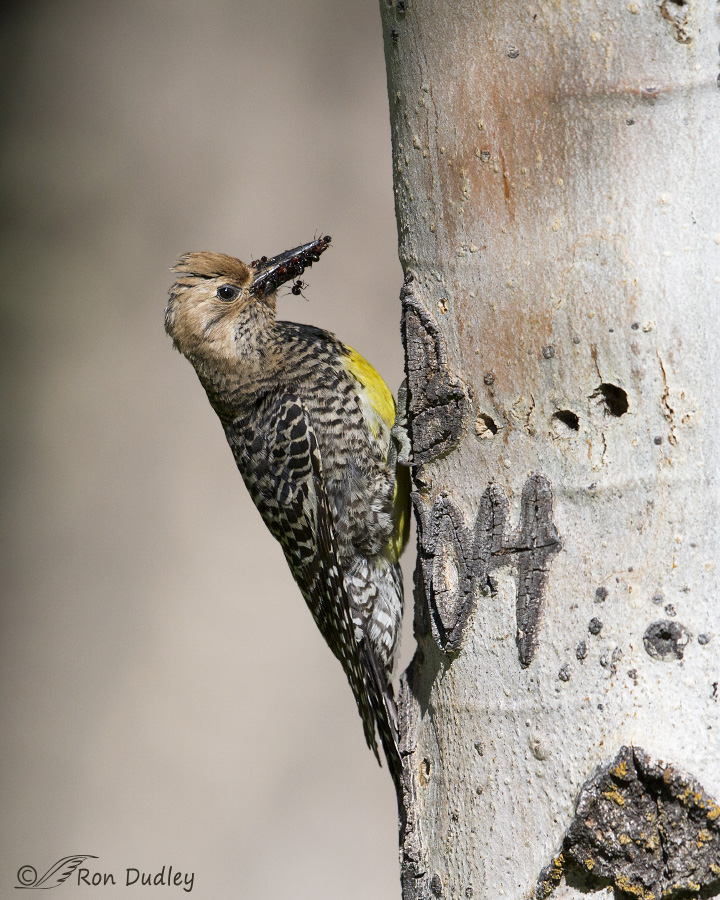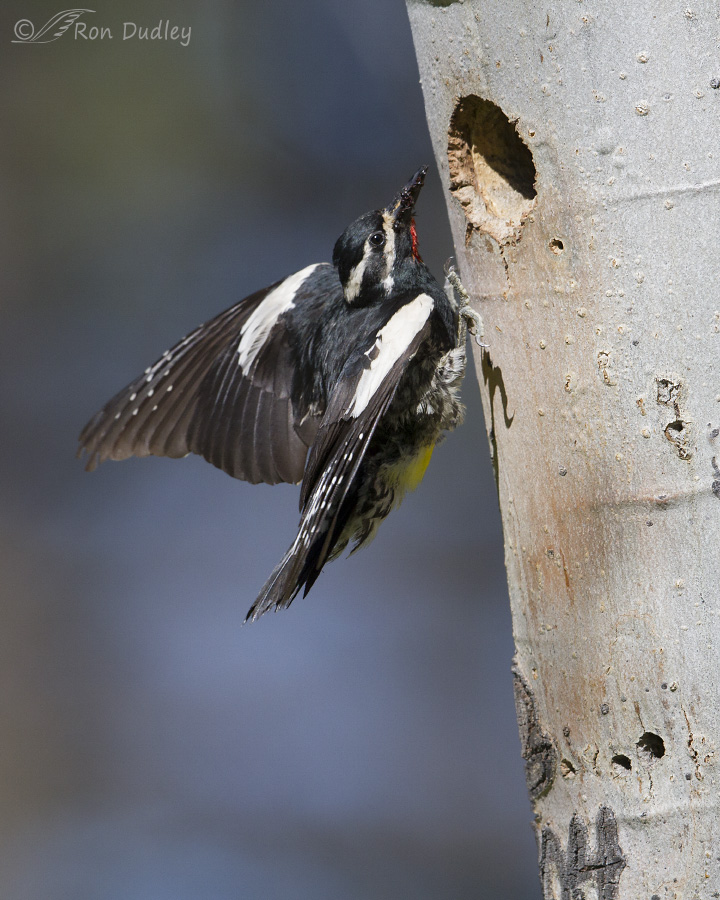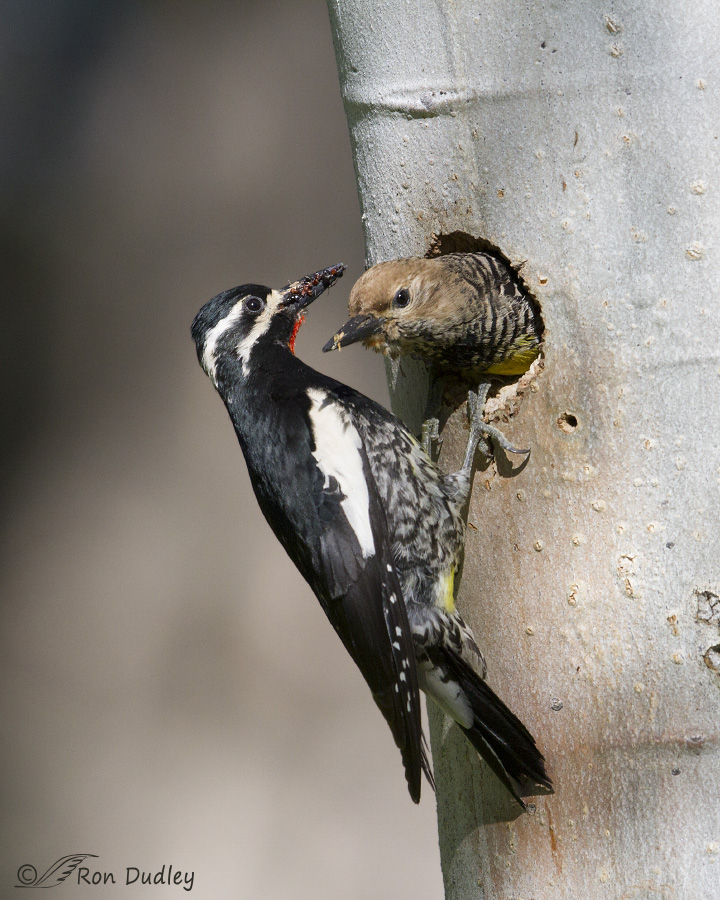Over two seasons (summer of 2014 and spring of 2015) I became very attached to and thoroughly enchanted by this pair of mated Williamson’s Sapsuckers. They were nesting in a dead aspen in a campsite in southwest Montana and because of that location they were acclimated to a variety of close-up human activities including traffic, motorcycles, ATV’s, horse trailers, boisterous kids and barking dogs. They just went about their business of raising their family. While we were on location our presence kept more disruptive activities away from the campsite so I wish I could have stayed there until the chicks (which I only heard and never actually saw) were fledged.
I photographed these woodpeckers from inside my pickup and they were never disturbed by my presence (in fact I think they were relieved by it compared to the pandemonium they were used to). One time I used a tripod outside my vehicle and that didn’t disturb them either but it made me nervous that it might so I didn’t do it again.
 1/4000, f/5.6, ISO 640, Canon 7D, Canon EF 500mm f/4L IS II USM, not baited, set up or called in
1/4000, f/5.6, ISO 640, Canon 7D, Canon EF 500mm f/4L IS II USM, not baited, set up or called in
This is the female with a beak-full of ants for her chicks. The nest hole is a little over 1 foot above her but both adults would usually land exactly on this spot before delivering ants to the youngsters in the nest. I believe that was because the roughness of the bark caused by someone carving graffiti into the tree years earlier gave them a spot just below the nest that was easier to hold on to with their claws. From this position on the tree they would fly straight up the leaning trunk of the tree to the nest hole to deliver the ants.

1/4000, f/5.0, ISO 640, Canon 7D, Canon EF 500mm f/4L IS II USM, not baited, set up or called in
This is the male in the process of making that short vertical hop from the landing spot on the tree to the nest entrance. I’ve deliberately cropped this image to include the landing spot and the nest hole. Notice that his beak is also full of ants.
The males and females of other woodpeckers are almost identical but the plumage colors of the sexes of this species are so spectacularly different that for many years early naturalists reported them as different species.

1/3200, f/5.6, ISO 640, Canon 7D, Canon EF 500mm f/4L IS II USM, not baited, set up or called in
Typically one adult would be in the nest when the other arrived so I was able to get a variety of shots that included the two of them. Here the female is preparing to leave the hole (thus the leaning posture of her mate to avoid having his head taken off during her explosive exit) and the male is about to deliver his load of ants to the chicks after she leaves. She has some wood chips on her bill left over from her housekeeping duties inside the nest cavity.
Since our weather forecast for the next week looks dismal and dreary and I likely won’t be able to be out photographing birds much I thought this would be a good opportunity to share some sapsucker images that I haven’t posted previously. So it’s my intention to follow up this introductory post with some interesting behavioral images of these birds sometime in the near future, perhaps as early as tomorrow.
At least that’s my intention but you know what they say about “the best-laid plans of mice and men” so we’ll see what really happens…
Ron


Lovely shots of close-up behavior! Don’t know if anyone posted this, but according to Cornell, woodpeckers and sapsuckers have barbed tongues, coated with sticky saliva, just for such tasks.
Really spectacular! I love seeing how critters live.
I’ve never understood how these birds can pick up so many ants at one time without dropping the first ones…wonder the samethingvabout Puffins, who somehow end up with a whole bunch of fish dangling out of their beaks….
Beautiful, I love the dangling ant in the first photo and the two birds by the nest hole. I know what you mean by explosive exit, I have observed that behavior in other sapsuckers and woodpeckers. Do you think it is because they feel vulnerable while exiting that they do this?
I wish humans would understand the importance of old wood and undergrowth. I have Red Butte creek behind my home and after the oil spill the city decided to rebuild the creek bed to a more natural shape. However in doing so they cleared out all the old trees and undergrowth along the park. I have noticed less Western Screech Owls,Song Sparrows and towhees, I think all the California Quail moved into my yard.
“Do you think it is because they feel vulnerable while exiting that they do this?
April, it seems to me that they do it (push off from the hole explosively) in order to get as much speed for flight as quickly as possible so there’s less flapping required at the onset. I’m speculating about that though…
There’s a lot of concern among naturalists and others that many municipalities clear out “old wood” without thinking of consequences for birds, especially during the nesting season. You raise a valid concern, April.
Old, dead, as you know, not only provide nesting sites but also, via the insects in them, provide food… “Cleaning” up the woods of dead trees, is ignorance in action…
And humans are so darn ignorant! Seriously…ignorant and arrogant. Hate that combination with my species!
Excellent behavioral shots, and very interesting to me, since our primary ant eater is the Northern (Yellow-shafted) Flicker.
Also, our Yellow-shafted Sapsucker is more interested in making the sap run and can do significant damage to trees.
The Williamson’s Sapsuckers is a good looking bird and I enjoyed these series very much.
Sorry got carried away with yellow-shafted – should be Yellow-bellied Sapsucker!
Dick, these birds consume a lot of sap too during other times of the year. But they switch over to ants during the nesting season. In fact this species has a higher dependence on ants than any other North American woodpecker.
These birds are so sweet and made my mind wander to how people take care of their babies. I wonder who actually does the better job? 🙂 Beautiful, just beautiful.
Kathleen, from what I observed over many days of observing these birds they’re devoted and hard-working parents. If only all human parents shared those some characteristics…
Please don’t you and Mia get so “antsy” about getting out of the cabin” that you put yourselves at risk…you both probably have thousands (literally) of archived great shots to share….
Agreed, Patty – the roundness of the hole always catches my eye.
We got out this morning for a little while but we had to go south to a less birdy area to find any sunshine so we didn’t gat any great photos. Helped a little with the cabin fever though. Thanks for your concern.
Bittersweet – and beautiful.
I also really, really liked hearing that the grafitti which (to my eyes) defaced the tree served a useful purpose.
You make a good point about that damned graffiti, Ec. I just don’t understand why people feel the need to deface trees like that.
Once again, I’m impressed ( and curious) about how perfectly round this bird-made hole is. Bird engineers can make such amazing structures….I always wonder how they do it……
Great shots.
Thank you, Dave.
Great shots, Ron. 🙂 They do look like different species except for the yellow on both. The Northern Flickers here work the ant hills in the yard, but have never seen them with a beak full/crawling on them – glad they don’t bother them cuz I couldn’t handle a mouthful or them crawling on my face! 🙂
Judy, I’ve never understood how so many birds can tolerate eating ants because of the formic acid they contain.
I’ve always enjoyed your captures of these beautiful sapsuckers and their activities…so nice to see them again…must admit that this was bittersweet, as seeing that tree “high rise apartment house” again made me sad, mad and depressed–knowing its history…
I think of that disaster every time I see one of my photos of these birds, Patty. It’s hard not to…
Hi Ron. I came across your site about a month ago while searching for wildlife/birding blogs and find that I’m visiting every day to read your interesting stories and view the great images you post. They are both fascinating, well done, and educational. Thank you.
Welcome aboard, Dave! I hope you continue to find your visits here educational and fun.
Not to be repetitive or anything, but just WOW, what a spectacular series of photos!! And they’re not even raptors 😀
I’m fascinated watching the various behaviors of nesting birds. It started with the Cornell Redtail Hawk nestcam, but expanded from there. I love watching how the adults interact with each other and how they parent as they raise their broods. Overall, I think humans could learn a LOT about parenting from birds.
And once again, thank you for letting me join you on your journeys every morning as I wake with my coffee and the dogs curled up by my side. What a splendid morning ritual!
You can be repetitive like that any time you like, Laura. 🙂
And I agree with you about “watching behaviors”. It can be so fascinating that occasionally I’m in danger of forgetting to click the shutter!
Yep even seasoned photographers who’ve gone out hunting with me have suffered that jaw-dropped-on-the-ground issue in lieu of snapping the camera. I’ve had to remind them that they had a camera for two of Mariah’s most memorable days…LOL!
I remember these awesome shots and the horrid result of cutting down their home. The same thing happened to me with a family of Red headed Woodpeckers and it’s really disappointing!
Charlotte
Charlotte, yes, the tree being chopped down was a heartbreaker. I can tell that you know that feeling.
Actually these images have never been posted before but some of them are similar to shots I have posted.
I love that one little ant dangling from her beak in the top photo! Thanks again for a wonderful start to the day!
Thanks, Diane. I agree, that individual ant adds a lot to the photo.
Good morning, Ron!! Florida has been dealing with some really bad weather this morning and the West coast seems to have gotten the worst of it. Hope Shannon and family made it thru ok! Now for your series – which I love!! I’m curious if this is the tree some fool cut down?!! It’s amazing how different the male and female are. I’m on my Kindle Fire so can’t wait to see them on my desktop with it’s much bigger screen!! I especially love the 1st one where you can see one of the ants falling from the female’s beak. I guess it will live to see another day!!
Jo Ann, Yes, this is that same tree.
I’ve been reading about your storm this morning – it sounds like a doozy. Good luck with it!